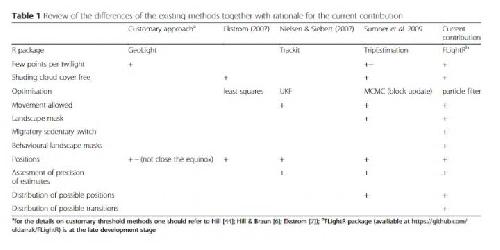The ability to track animal movements across long distances has revolutionized our understanding of animal ecology and has been helpful to conservation. Until recently, our ability to record this information was limited to larger animals that could carry satellite transmitters. However, recent technological advances have developed miniaturized devices that extend our ability to track much smaller animals, especially migratory songbirds.
Solar archival tags (henceforth called geolocators) are tracking devices deployed on animals to reconstruct their long-distance movements on the basis of locations inferred post hoc with reference to the geographical and seasonal variations in the timing and speeds of sunrise and sunset. The increased use of geolocators has created a need for analytical tools to produce accurate and objective estimates of migration routes that are explicit in their uncertainty about the position estimates.
The model developed for the analysis of geolocator data estimates tracks for animals with complex migratory behaviour by combining: a shading-insensitive, template-fit physical model, an uncorrelated random walk movement model that includes migratory and sedentary behavioural states, and spatially explicit behavioural masks.
 This is a review of the differences of the existing methods together with rationale for the current contribution. Credit: Authors from the article.
This is a review of the differences of the existing methods together with rationale for the current contribution. Credit: Authors from the article.
The model is implemented in a specially developed open source R package FLightR. By analyzing both simulated data and real tracks, researchers demonstrated that this approach has greater precision than the threshold method, which is by far the most commonly applied analysis technique in the literature. For two birds that migrated along the coasts of North America, this approach, without any geographic masks, reconstructed a path that closely matched the coastline.
The model provided increases accuracy in analyses of noisy data and movements of animals with complicated migration behaviour. It provides posterior distributions for the positions of animals, their behavioural states (e.g., migrating or sedentary), and distance and direction of movement. Our approach allows biologists to estimate locations of animals with complex migratory behaviour based on raw light data. This model advances the current methods for estimating migration tracks from solar geolocation, and will benefit a fast-growing number of tracking studies with this technology. In addition to providing more precise locations, this method provides data on the probability of movement behaviour that can be used to test behavioural hypotheses.
source: Kazan Federal University